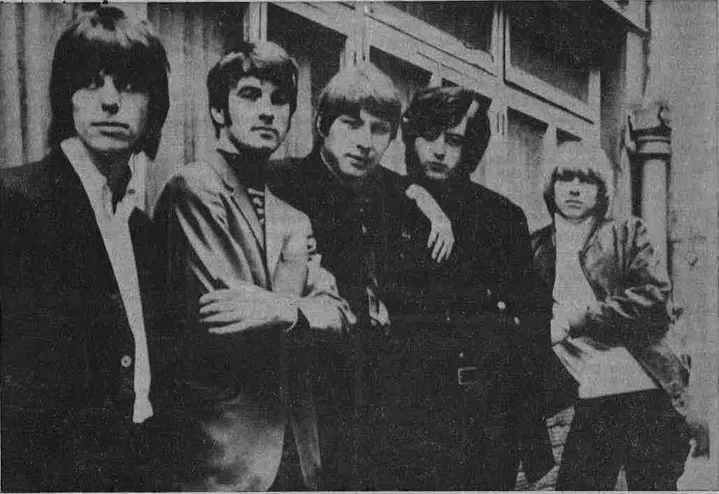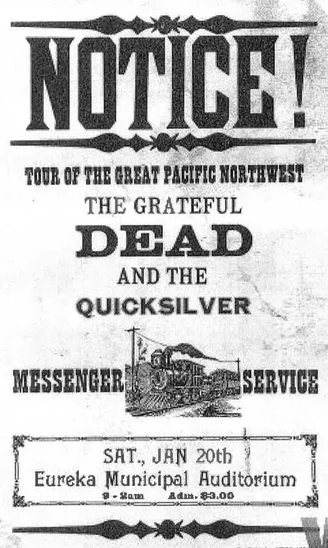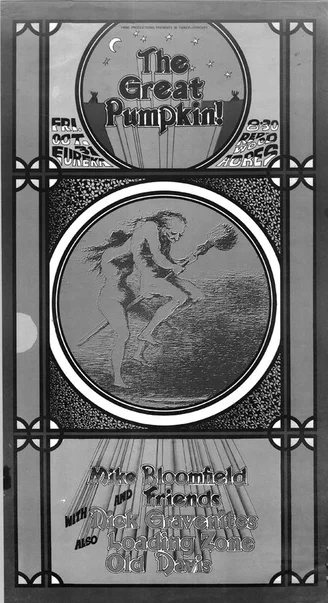Promotional photo of The Yardbirds as it appeared in the Eureka Times-Standard. Photos via the Humboldt Historian.
In 1966 I was a junior at Fortuna High School. At night, I would often sit in my parents’ car in the cold garage and listen to the music played on the San Francisco radio station KFRC. Some of the music was bland and sentimental. But some of the music was pure dynamite — blazing guitars, pounding drums and desperate vocals.
I felt the urgent power of rock music. It seeped into me and it made me feel part of something larger than myself and the town of Rio Dell where I grew up. Few of my friends had the same reaction. I was just an isolated son of a logger — looking to find more despite living in what seemed to me a cultural backwater. So, I had a strong feeling of restlessness. I wanted to move to the big city, where, looking back, I now realize that I would have simply been lost in the crowd. I am glad that I stayed put, for as it turned out, I found musical treasures in Humboldt County in my early years that affected me deeply.
Probably the most amazing and unlikely appearance by any band during this time was in the autumn of 1966 when the British group The Yardbirds played the Eureka Municipal Auditorium. The Yardbirds were very well-respected and popular, and more than any other band at the time, they were a home for some of rock’s greatest guitarists. Eric Clapton was their original guitarist, but when the band hit Eureka, it boasted two heavyweights: Jeff Beck and Jimmy Page. Looking back, it seems incomprehensible that these guys did a concert in Eureka (and also in Arcata on the same night). I recall being right up by the stage, and though the vocals were drowned out somewhat, it was mesmerizing to see these guys in action. One specific moment that I recall is that when the band was through playing, a girl to my right in the audience started waving her arms and yelling at Jimmy Page. After a moment, she was able to attract his attention. She yelled out asking for his guitar pick. He smiled, bent down at the edge of the stage, and handed it to her — also giving her a gracious smile. This actually happened over fifty years ago, though that does not seem at all possible. I wonder where she is today.
Rock pioneer, street poet and guitar innovator Chuck Berry played the Eureka Municipal Auditorium and Humboldt State on two separate trips to the area. He was a master showman with his patented on-stage duck walk and his clear, ringing guitar playing. His performance in Eureka was witnessed by the largest crowd that I have ever seen at the Municipal Auditorium.
The Grateful Dead played the Eureka Municipal Auditorium on January 20, 1968. Considering how many studio and live recordings have been released over the years by the Dead, and all their devoted fans, it’s amazing to think that when the band played in Eureka it was only just months after the release of their first album. The group consisted at this time of their original members and even back then they were experimenting with their unique improvisation and their innovation of blending one song into another. An interesting note is that Eureka was the Dead’s first stop on their first-ever multi-city tour, which included only four cities, Eureka, Ashland and Portland, Oregon, and Seattle. Also, it is sad but true, this was the first and only time this revered band ever played in Humboldt County. And what was the ticket price for this concert? A mere $3.00, which was the price for almost all the shows in these years. The cost of going to a concert being what it was meant that pretty much anybody could afford a ticket — no one was priced out of attending, as is the case today. Live music was accessible to everyone.
During this time it was fairly common for veteran bluesmen to tour college campuses. One such show came to Humboldt State featuring Bo Diddley, John Lee Hooker, and Charlie Musselwhite. I remember John Lee Hooker sitting on stage in a chair growling through his set of raw music. Performing that night in Charlie Musselwhite’s band was a very young Robben Ford. This guitarist, originally from Ukiah, has had a long career as both a rock and jazz guitar player.
When the Chicago-based Paul Butterfield Blues Band broke up, both of the band’s illustrious guitarists, Mike Bloomfield and Elvin Bishop, moved to the Bay Area. Elvin Bishop came up to Humboldt on two separate occasions. His shows were very energetic, with his infectious personality and his blues-based guitar virtuosity.
Mike Bloomfield and his band played an indoor concert at Redwood Acres on October 31, 1969. Considered one of the most eminent guitarists in the U.S. at the time, he was a craftsman when it came to blues guitar, and his performance featured several slow, aching solos.
Another remarkable appearance during this time — and a concert I did not see myself, but only heard about, so I will put an asterisk on this one — was when two brothers from Florida (who were living temporarily in California) showed up with their band called the Allman Joys. The brothers were Duane and Gregg Allman, and this was before they had a recording contract and changed their name to the Allman Brothers. Unlike the musicians mentioned above, they would have probably been completely unknown to most of those who were lucky enough to see them.
It is noteworthy that all the performers noted so far are in the Rock and Roll Hall of Fame (except Robben Ford and Charlie Musselwhite). I remember another future Hall of Famer who played the Eureka Municipal Auditorium somewhere around this time with his band called the Blue Buffalo. It was not an especially memorable concert, but the leader of this group was Dewey Martin. He had been the drummer for the defunct Buffalo Springfield who were later (years after this concert) inducted into the Hall of Fame.
In addition to the concerts I have listed above, there were plenty of other concerts, primarily at Humboldt State, given by bands and singers, and all were great events. Among those giving live performances were Canned Heat, The Grass Roots, The Association, The Flying Burrito Brothers, The Nitty Gritty Dirt Band, Country Joe and the Fish, Commander Cody, Lamb, The Quicksilver Messenger Service, Clover, The Youngbloods, It’s A Beautiful Day, Buffy St. Marie, John Stewart and Maria Muldaur.
In the summer of 1969, I saw Texas rocker Doug Sahm and his band, The Sir Douglas Quintet, at the Eureka Municipal Auditorium. There was something about that night and the Tex-Mex blend of music that was magical. It was a warm July evening and the churning mix of organ and guitar evoked a faraway place. I followed Doug’s musical career with interest and devotion from then on, and subsequently saw him and his band several more times over the years.
There was also in Humboldt County at this time a second tier of live music venues where one could see the struggling musicians — hard-working folks who I could relate to on a more personal level. There were three such locations: The Lemon Tree in Arcata, The Olive Branch in Eureka, and The Fig Twig in Ferndale. I attended numerous shows at the Olive Branch, a very comfortable concert and dance hall where I always felt completely at home. Often on weekends a band from the Bay Area would be on stage. Most of these bands were relatively unknown and usually had no record releases, but that did not matter as the music was always loud and the atmosphere festive. One show in particular that I remember was an appearance by the Sons of Champlin, a great band with a precision horn section. If there was not a band from the Bay Area performing, it was usually the unofficial “house band” of the Olive Branch, God’s Country, who took the stage. This group, which included Mike Stull, was the premier homegrown Eureka band at the time and played frequent concerts in the area.
In February 1970, I was in San Francisco and saw the Grateful Dead at the Fillmore. Also on the bill that night was a band called Bigfoot (contrary to what their name might imply, the group was from Los Angeles).
A weekend night a few weeks later at the Fig Twig, the band that took the stage was none other than Bigfoot. Between sets, I saw their keyboard player standing near me so I walked up to him and said something to the effect that: “I saw you at the Fillmore sharing the bill with the Grateful Dead and now you are way up here playing the Fig Twig. Quite a contrast.” In a slightly irritated manner, he looked at me and said, “Man, you can get heavy or you can get light.” He then promptly walked away. I have never forgotten this moment, thinking that this seemingly trite observation was a kind of a simple but recognizable summation of the times that we were living in.
I acknowledge that my recollections above are not the full picture of music in Humboldt County at this time. I was not in the position to hear much live music in the Eureka area in the summers of 1968 (I worked, and was stuck all summer, along the Mattole River between Petrolia and Honeydew); 1969 (lived and worked in Myers Flat); and 1970, 1971 and 1972 (lived and worked in Mendocino County, near Fort Bragg). So, there may have been great performances that to this day I am not aware of. I was most fortunate, though, that during the three summers I spent on the Mendocino Coast, there just happened to be an incredible rock and roll band that played and lived there during this time. They were originally from New York City (their first album was recorded there and was produced by Jimi Hendrix), but they somehow ended up in Northern California. I saw them in person upwards of fifteen times. The band was Cat Mother and they will never be forgotten by folks in that area.
From what I remember, those attending these shows were almost exclusively under the age of twenty-five. As far as rock music was concerned, there was a definite generation gap during those years. Rock music was generally denounced and vilified in newspaper editorials, from church pulpits and by social commentators. It was considered to be mindless noise created by ill-bred degenerates. It was dismissed as an unfortunate fad that could not fade away into oblivion soon enough. Even within my generation, there were plenty of classmates and friends who all but completely ignored it. Still, it persisted and prevailed. I do not mean to exaggerate its importance. In the big scheme of things, it is perhaps not all that significant. However, back when I was just a small-town kid in the audience at these shows, I felt a power and energy and connection that helped define my life. I felt part of a movement — and I am so glad such a feeling was possible at such a place and at such a time.
###
The story above was originally printed in the Winter 2017 issue of the Humboldt Historian, a journal of the Humboldt County Historical Society. It is reprinted here with permission. The Humboldt County Historical Society is a nonprofit organization devoted to archiving, preserving and sharing Humboldt County’s rich history. You can become a member and receive a year’s worth of new issues of The Humboldt Historian at this link.



CLICK TO MANAGE